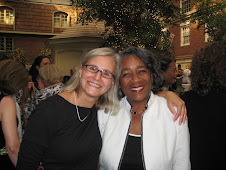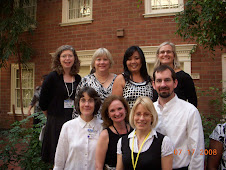After Chris, KC and Sarah reported great success with the Key Word Notes strategy, I wanted to try it. I was amazed both times that I have used the strategy this week. The students were able to synthesize the information being learned into high level summary statements.
The first time that students completed Key Word Notes was Monday during setting presentations. Each base group presented information on the details of a different setting in Brave New World. Those presentations also included information regarding Huxley's intent for including such a detailed setting in terms of character development, symbolism or theme.
While a group was presenting, all other members of the class had to listen attentively and come up with a one-word summary of the entire presentation. Not only was I amazed that the audience was practically on the edge of their seats to cue into a key word, but also the words that were chosen were usually at the symbolic or thematic level. Words like sterile, brainwashing, unnatural, inhumane and conformity were captured on the Key Word Notes page of their notebooks. After each presentation, I asked a few students to share their words and reasoning, and again students displayed a high level of thinking during this synthesis activity.
In fact, the summary sentence at the end of the Key Word Notes chart was often a thesis statement for an essay on Huxley's intent regarding setting details.
The second time that I used Key Word Notes this week was during a classroom discussion. The last time that we had a full day of classroom discussion on the novel, I noticed that many students were tuning out, and I was kicking myself for not providing some type of formal reflection activity. So today, which was slated to be another full day of classroom discussion, I had students create a Key Word Notes chart. After about seven minutes of an open forum discussion (where students pose questions for other students to answer), I would say, "Timeout! Summarize the past seven minutes into one word."
After each reflection minute, I had a few students share their word and reasoning. I was disappointed that the words chosen were not as high level as the ones earlier in the week during the setting presentations. There was no unifying theme for the seven minutes prior to reflection time because two or three unrelated questions were posed by the students. I feared then that I had misused the Key Word Notes strategy in this artificial task.
I feared that the words were so disconnected that the summary sentence would not make sense or be too difficult to write. Before I had students write the summary sentence, I told them that this sentence should capture their closing thought of the day; what they had gotten out of today's discussion. I was pleasantly surprised that the sentences shared were as high quality as the setting ones earlier in the week.
I've concluded that the Key Word Notes strategy gives students the framework to make personal meaning out of classroom discussions, even when a number of various topics and questions are raised.
Showing posts with label key word notes. Show all posts
Showing posts with label key word notes. Show all posts
Thursday, September 20, 2007
Wednesday, September 12, 2007
Key Word Notes

The Key Word Notes strategy allows students to restate information from readings and lectures in their own words to increase comprehension and retention.
Strategy Step by Step:
- Students make a chart of boxes (see above) in their notebooks.
- The teacher divides the reading into four sections.
- Students read the first section of text and then stop to reflect. During reflection, teachers may want students to discuss the reading with a partner or base group.
- After reflection and/or discussion, students write just a few words in the appropriate box. Alternatively, students could write the key words first and then discuss with a partner about why they wrote those specific words.
- Students repeat the process with the next three sections until the top four boxes all have key words noted in them.
- Then in the bottom box students write a summary sentence (two at the most) about what they learned in the reading. Students may or may not incorporate the key words from the top boxes in this sentence.
The Key Word Notes strategy also works with lectures. Students may be taking detailed notes on one page of their notebooks, but then on another page they have their Key Word Notes chart. This chart will provide for summary and reflection as the teacher pauses four times during the lecture to let students jot down and discuss their key words.
Key Word Notes also works well for students during a research paper or project unit. Students simply record a few key words from each source in a box. In fact, this strategy was devised from a high school teacher concerned with plagiarism during a research paper unit.
The number of boxes can also be varied if a reading or lecture fits logically into 6 sections, etc.
Chris Dalki, KC West and Sarah Burgess (nee Striffler) have all reported great success so far this year with Key Word Notes. Enriched Sociology students used the strategy with a nonfiction piece.
Enriched English 10 students used the strategy to share information from their summer reading journals with a partner. Students wrote down ideas after their partner sharing in a Key Word Notes chart set up with boxes labeled: main character, other characters, images and big ideas. After writing their summary sentences, students then discussed the themes that they saw in the book. KC and Sarah reported that this was an awesome lesson.
I will try this strategy in a few days during a discussion of Brave New World to give students a chance to reflect on the discussion occurring in the classroom and to capture those key ideas.
Labels:
cognition,
key word notes,
language strategies,
reading,
writing
Subscribe to:
Posts (Atom)






